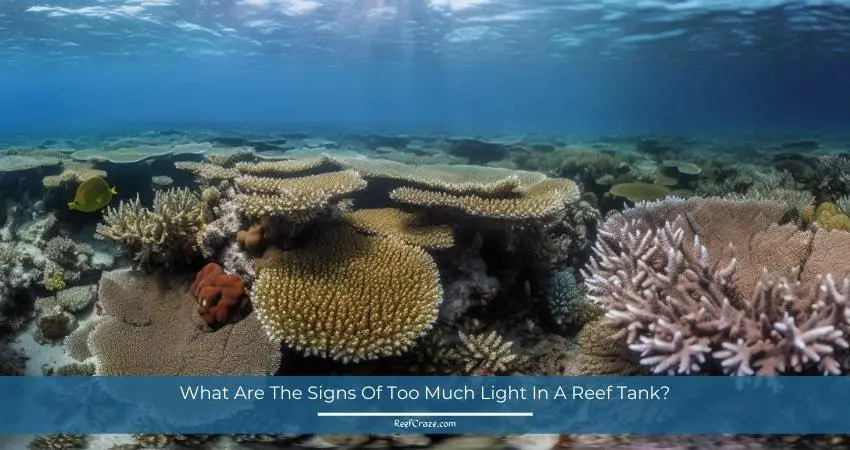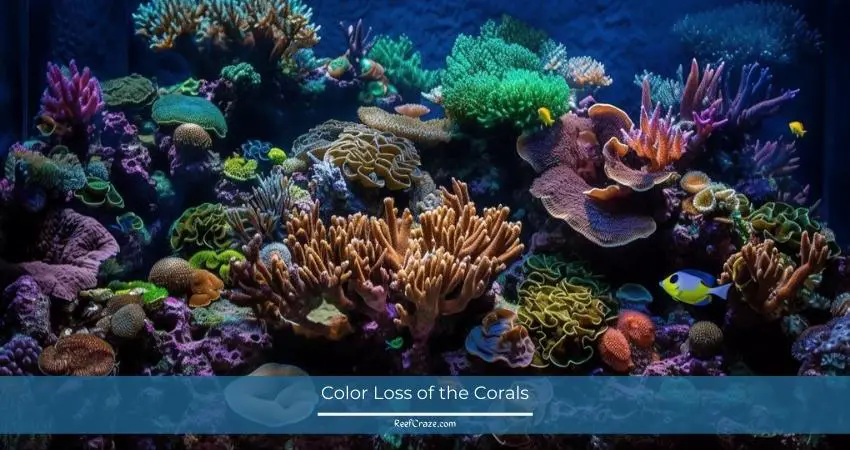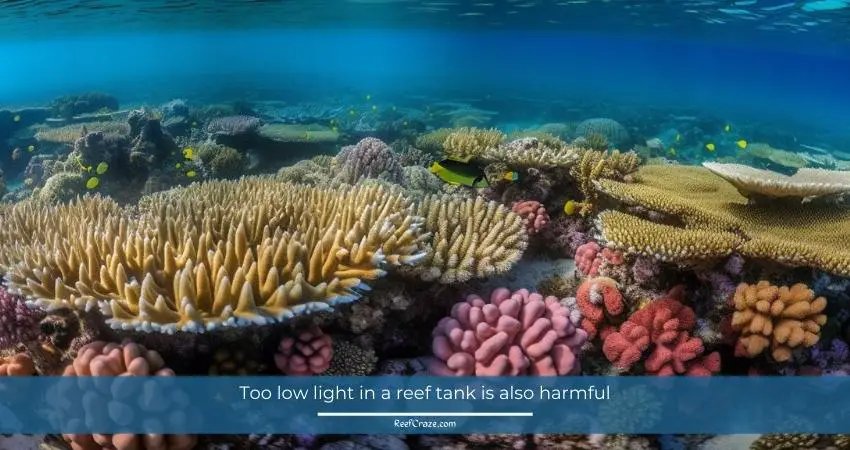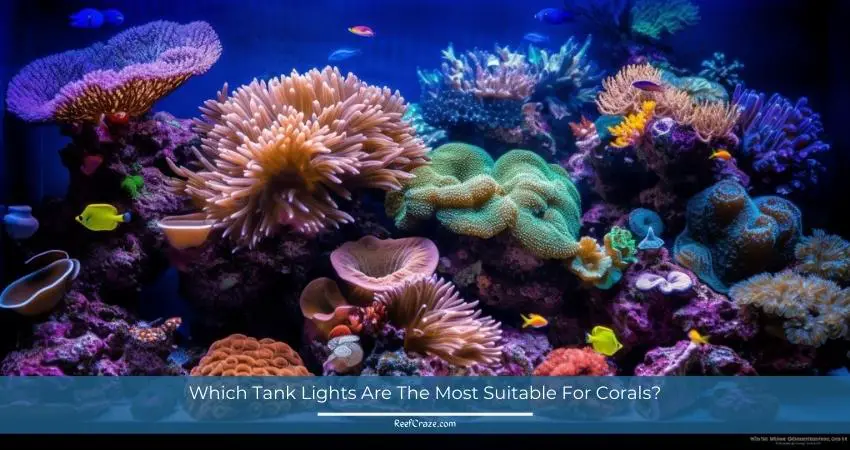As reef tank enthusiasts, we know that lighting plays a crucial role in maintaining a healthy and thriving environment for our marine life. However, finding the perfect balance between too little and too much light can be a delicate dance.
The initial sign of too much light is coral bleaching, losing tissue, and losing color. Another symptom is its reduced size. Higher lighting can lead to Coral’s death within 7 days.
In this article, we’ll explore the signs of excessive lighting in your reef tank and discuss how to recognize when your underwater world might be getting too much of a good thing. By understanding the potential consequences of excessive light exposure and learning how to identify the warning signs, you’ll be well-equipped to ensure your coral and aquatic inhabitants continue to thrive in their aquatic paradise. So, let’s dive in and illuminate the topic of excessive light in reef tanks!

Why Is Reef Lighting Important For Corals?
The ecosystem of your reef tank is entirely dependent on light because of photosynthesis, a process that supplies corals with 80% to 85% of their energy.
Besides, lighting stimulates Coral’s chromoprotein, which takes care of the vibrant and lively colors you see inside your aquarium. That explains why lighting is fundamental maintenance for this marine species.
What Are The Signs Of Too Much Light In A Reef Tank?
1. Color Loss
When your Coral begins to lose color, take it as the first alarming sign of your lighting arrangement and lower it carefully. Becoming white or turning pale is their immediate response to excessive light.
The reason behind Coral bleaching has to do with the Zooxanthellae algae associated with your Coral’s body. They have a symbiotic relationship where the algae population helps Coral with photosynthesis and nutrition collection.

Too much light in your reef tank causes the algae to die and Coral tissues to fall off. Thus, it turns pale and colorless, suffering from coral bleaching.
Heat is also responsible for this condition and is directly related to light intensity. Hanging the lights too close to the tank (below 7–8 inches vertically) will make the internal environment extremely hot and speed up the bleaching.
You must lower the lighting frequency upon noticing the unhealthy symptom in your corals. But be cautious about doing it slowly. Decreasing the intensity quickly at once will give them adjustment difficulties and exacerbate their situation.
2. Size Reduction
The other sign is the shrinking size of Corals. Too much light might give you the idea that your Coral will get more energy and increase in size. But in reality, the opposite will happen instead.
However, it is not obvious to occur. It may or may not be present along with the color loss.
What If There Is Too Low Light? Is That Harmful Too?
Yes. Too low light in a reef tank will also impact your corals negatively. That again brings back photosynthesis.
The process needs sufficient light for Corals to generate their energy. When the light intensity is too low, they cannot produce enough food. As a result, the algae starts to populate fast to provide more food in that lighting arrangement.

In that circumstance, the color pigments of your Corals will begin to dwindle because of the inversely proportional relationship between pigment concentration and Zooxanthellae algae growth. Besides, the algal bloom will deteriorate the health of Corals. Should it continue for a while, it will cause their demise because of insufficient nutrition. Their growth will slow down, and size will reduce, followed by death.
It is a common problem for newly set reef tanks. You must keep lights at a safe distance, which should be vertically at least 8 inches long. And going above the limit may bar your Corals from getting enough light as the intensity wanes with distance. That could explain why they are turning brown suddenly.
What Is The PAR Requirement Of Corals?
PAR is the initial for Photosynthetically Active Radiation. Zooxanthellae algae need a specific range of lighting for photosynthesis, and PAR helps you measure that.
PAR, a measurement basis, gives aquarist data about the light available for corals and plants to perform photosynthesis. It is compulsory for reef tanks and planted aquariums that rely on this process for survival.
There are 2 main types of coral – soft and hard. Soft Polyp Stony (SPS) and Large Polyp Stony (LPS), belonging to the first category, require 100-200 and 200-400 PAR ranges, respectively. On the other hand, it is generally 70 to 150 PAR for Soft Corals to develop healthily.
The following table presents more data about the PAR requirement of various Coral types.

You have noticed that some Corals significantly deviate from their specified range per their respective categories. That is because when given the time to acclimate to intensity changes, individual Coral types can adapt to a broad light range due to their high resilience.
Note that you cannot only focus on PAR measurement. You must also observe them carefully and make necessary adjustments in your tank environment based on the demands and reactions of each Coral.
Lastly, know that the measurement of PAR values comes in the unit of µmol/m²/s as PPFD, standing for Photosynthetic Photon Flux Density.
How To Ensure The Photoperiod Accurately?
Corals are photoperiodic in that they react to the comparative lengths of dark and light periods. So, maintaining natural and proper lighting times plays a crucial role in that regard.
The rule of thumb is simple. In the case of higher PAR levels, limit the period to around 9 hours. That will be a suitable starting point. If the PAR values are on the lower side, increasing it to 12 hours will provide better results.
Which Tank Lights Are The Most Suitable For Corals?
Aquarists use both fluorescent and metal halide lighting for their Corals. But the second one is the best as its blue light is deeper than that of fluorescent light, which is only suitable for a FOWLR tank.
Building a reef aquarium needs lighting depth. An insufficiency of that will cause your Corals to turn brown. Although fluorescent light is less expensive and preferable to reefers, it is fragile, with a frequently shifting color temperature of 12000k. Experts do not recommend it for reef and planted aquarium systems.

Fluorescent light will do the job temporarily, but you should contemplate the long-term necessity. Metal halide is more powerful with a higher color temperature of 20000k. Plus, it is not as fragile as the other one. Remember that corals need high light for survival and growth.
Moreover, metal halide degrades slower than fluorescent light while providing a better Color Rendering Index (CRI). Hence, it is the best-suited lighting arrangement for a reef tank.
But there is a drawback of MH in its capacity to generate heat. It provides higher heat due to its higher power. So you cannot keep it too close to your aquarium. Make sure the vertical distance is no less than 8 inches. If not, your Corals will die from overexposure.
Note that every blue light has 400 to 500 nanometers of wavelength best for corals and plants to conduct photosynthesis. Here MH gets priority over FL due to its color depth and lighting intensity, which is positively proportional to PAR values.
Is Blue Lighting Essential For Corals To Grow?
Corals are most active when the lighting wavelength is between 400 and 700 nanometers. Also known as PAR, it is the best range for photosynthesis.
Per the last section, the wavelengths of blue lights serve the needs of Corals to participate in their food and nutrition collecting process. So yes, it is essential for their growth.
Red lights are also important as they have a higher wavelength of 600 to 700 nanometers. Although white lights suit a reef tank best, according to some reefers, it is not entirely true. White light alone cannot generalize the required photosynthetic wavelengths for Corals.
Blue lights are more effective for raising the PAR levels. You can use white lights to see the tank perfectly because blue light will not be that helpful. But you cannot downright depend on white lights to contribute to the discussed purpose.
TIPS!
Following the tips below, you can check that your corals do not suffer from too low or too much light in your reef tank.
- First, observe the daily life and movements of your Corals regularly. It will help you learn their needs better.
- Measure the water parameters regularly because the lighting is not the only thing that affects their health.
- Maintain the photoperiod strictly. Deviation from the routine is not ideal for Corals.
- Finally, when you see everything is going alright inside your tank, let it stay that way. Overdoing it can be harmful as corals are highly delicate.
Final Words
To summarize, moderate to high lighting is the best match for Corals. Now you have to be alert about not arranging too low or too high light for your reef tank by setting it per the PAR level. Checking the PAR requirement before setting the lighting is a must.
Fluorescent light is not recommendable for a reef tank. Go for it if you have a regular freshwater or saltwater tank. MH gives the most desired outcome related to your Coral’s health and growth.
That is all about it. Happy reef-keeping!
